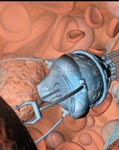
 Na XXI Cimeira Luso-Espanhola que decorreu em Évora nos dias 18 e 19 de Novembro de 2005, foi decidida a criação de um Instituto de I&D Portugal-Espanha, como iniciativa pioneira de um novo tipo de parceria institucional internacional em ciência e tecnologia na Europa.
Na XXI Cimeira Luso-Espanhola que decorreu em Évora nos dias 18 e 19 de Novembro de 2005, foi decidida a criação de um Instituto de I&D Portugal-Espanha, como iniciativa pioneira de um novo tipo de parceria institucional internacional em ciência e tecnologia na Europa.Ficou decidido que o instituto seria localizado em Braga-Portugal, teria como primeiro director um investigador espanhol (Professor José Rivas da Universidade de Santiago de Compostela, nomeado na ocasião pelo Presidente do Governo de Espanha) e deveria vir a ter cerca de 200 investigadores de Espanha, Portugal e outros países, com um orçamento operacional anual de cerca de 30 milhões de euros e um investimento adicional de igual valor, assegurados em partes iguais pelos dois países.
Com a criação deste instituto pretende-se reforçar a colaboração científica e tecnológica entre Portugal e Espanha, abrindo-se um novo ciclo nas suas relações e na construção de economias nacionais baseadas no conhecimento. Numa fase inicial o instituto envolve Portugal e Espanha, mas será aberto à adesão de outros países e à participação de instituições e de especialistas de todo o mundo, com o objectivo de se constituir como pólo de investigação internacional de excelência, desenvolvendo parcerias com instituições do ensino superior e com o sector económico, a promoção da transferência de conhecimento de valor acrescentado e gerador de emprego, e a formação de profissionais especializados.

Today:Dec. 3, 2007
In a world that constantly strives for bigger and bigger things, Washington University in St. Louis' Pratim Biswas, Ph.D., the Stifel and Quinette Jens Professor and chair of the Department of Energy, Environmental and Chemical Engineering, is working to make things smaller and smaller.
Biswas conducts research on nanoparticles, which are the building blocks for nanotechnology. For the first time, Biswas has shown that he can independently control the size of the nanoparticles that he makes while keeping their other properties the same. He's also shown with his technique that the nanoparticles can be made in large quantities in scalable systems, opening up the possibility for more applications and different techniques.
Nanotechnology has far-reaching applications in microelectronics, renewable energy and medicine, just to name a few. But the first step is synthesizing and understanding nanoparticles.
To put the size of a nanoparticle into perspective, compare it to a human hair. One strand of human hair is about 50 to 100 micrometers thick. One nanometer is 1/1000 of a micrometer. A nanoparticle is 100 nanometers thick.
"It's difficult to imagine dividing a meter up into a million pieces and then a nanometer is a thousandth of that," explained Biswas. "These are very tiny particles."
This small size is critical in the applications. By varying the size, nanoparticles can efficiently be tuned to perform a specific task, be it cosmetics or pollution clean up.
"When I reduce the size of the object, then the properties are very different. They can have certain unique properties," said Biswas. "By changing the size and the crystal structure you can tune the functionality."
Fabulous Flames
To make these nanoparticles and to alter their size, Biswas uses a flame aerosol reactor (FLAR). The flame provides a high-temperature environment in which molecules can be assembled in a single step.
Biswas described the technique and his work in a recent issue of Nanotechnology.
"Bring the material in, react it, form the particles and then collect it and go and use it," said Biswas.
This technique also allows for mass production, once the conditions to produce the desired material have been determined.
Controlling the size of these particles is what opens doors to new and unique uses.
"The applications are plentiful," said Biswas. "The other thing is, if I can make materials of very narrow sizes, I can study the properties as a function of size — which has not been possible in the past — with very precise controls so we can do fundamental research. And that allows me to come up with new applications."
Dig those crazy tires
Such new applications may even change the way we think about driving. Tired of boring, black car tires? With nanotechnology, tires could become a fashion statement with red, pink, blue, green, or "any color you want" as possibilities.
"All tires are black in color because of the carbon that is added. Which color you want is not important, because now you could add a silica-based material which will allow you to get any color of your choice," said Biswas. "Nanoparticles are going to be used everywhere. They are already being used in many applications — cosmetics, microelectronics — but now you are going to use it for tires."
With all of these new applications come budding new fields of study. One area is nanotoxicology, which researches the health and environmental safety of new materials containing nanoparticles. Nanotechnologists join forces with biologists to determine the safety of different-sized particles. For example, one size particle may provide the best effects in a cosmetic, but manufacturers must make sure that it shouldn't cause toxic effects in a person's body.
"We don't want to just release it to the environment. The general feeling is that you have to be proactive, make sure everything is OK and then go, so here you are trying to be as cautious as possible," said Biswas.
Biswas' work focuses mainly on making the nanoparticles, but his research has led to a variety of applications and collaborations. Biswas is currently collaborating with Sam Achilefu, Ph.D., associate professor of radiology in the Washington University School of Medicine. Achilefu is working to selectively deposit imaging agents. Rather than flood a cancer patient's body with a drug during chemotherapy, for example, nanotechnology and selective deposits could deliver and concentrate the drug in the region of the tumor.
"These are very preliminary," said Biswas, "but we're getting some neat results. So there are some cautious examples, like toxicology, but then there are many useful applications."
Biswas also stresses the importance in the global marketplace. Nanotechnology has the potential to purify drinking water for rural populations worldwide. Such efforts send a "big social message," said Biswas. Renewable energy is yet another possible application of nanotechnology.
The possibilities of nanotechnology are endless, and everyday Biswas embarks on this exciting journey.
"That's the beauty here. At Washington University we have a very strong aerosol science and technology group. I would say one of the strongest in this area," said Biswas. "Furthermore, there are many collaborators in different disciplines where we can explore new application areas. So our ability to make tailor-made nanoparticles with very tight control of properties will allow more applications to be invented. That's the driving force — the ability to synthesize nanoparticles. They are the building blocks of nanotechnology."
CRN/WULST




1 comentário:
lowest price viagra purchase viagra can viagra be used by women viagra results buy viagra cheap herbal viagra free viagra samples before buying uk alternative viagra buy viagra australian viagra and cannabis canadian viagra viagra generique viagra sales viagra online uk
Enviar um comentário